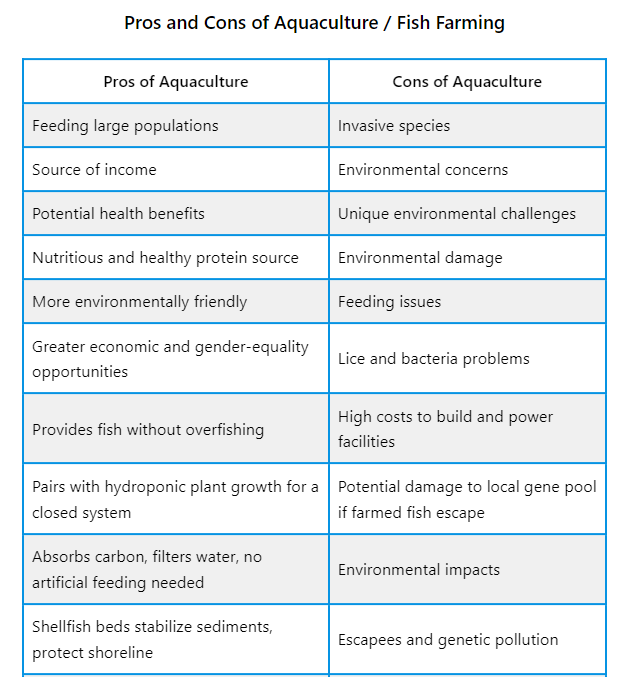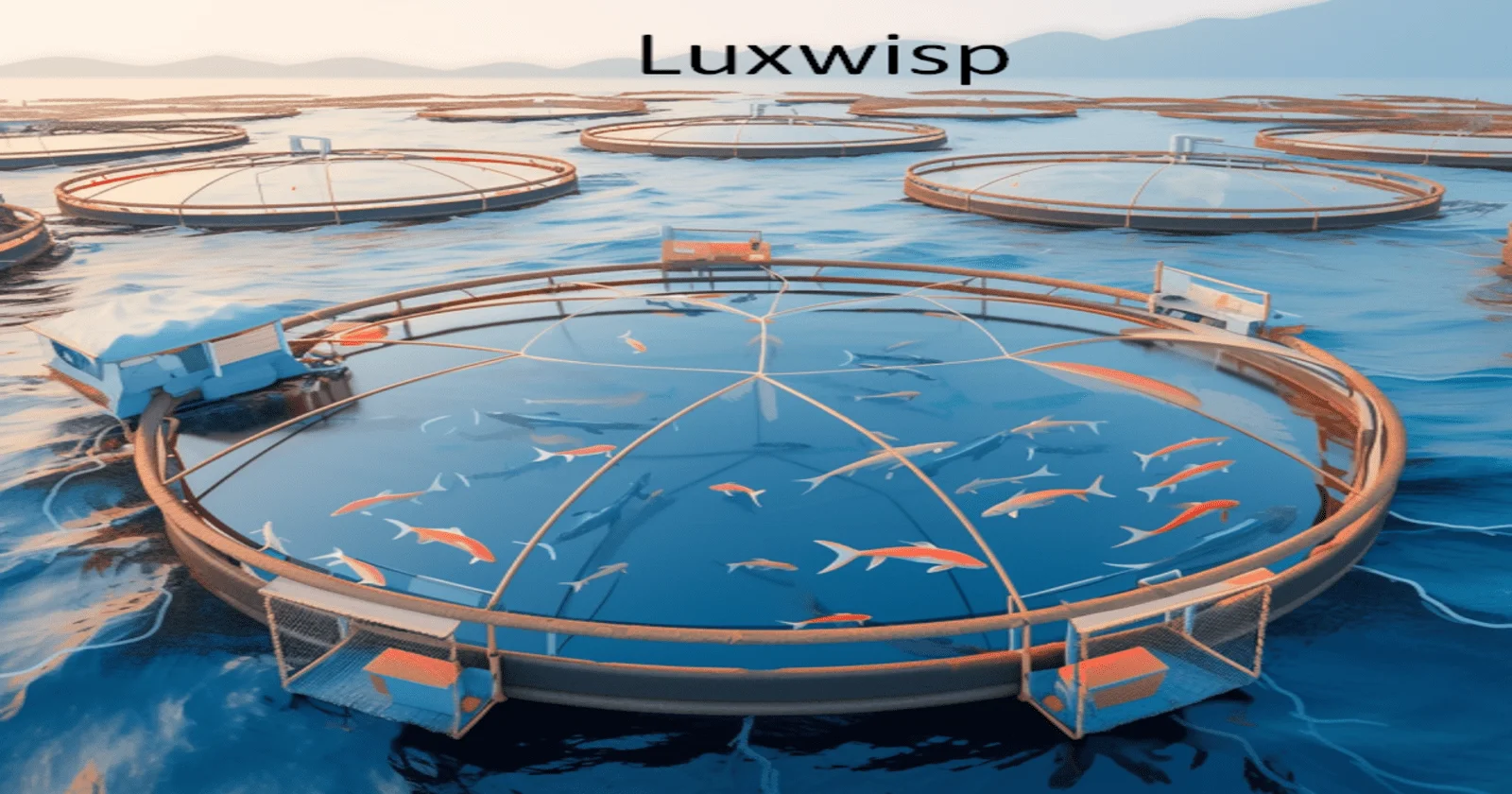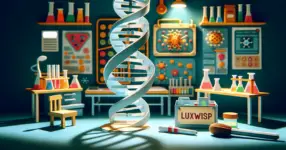The pros of aquaculture include feeding large populations with nutritious protein, providing income and health benefits, and being environmentally friendly. It offers economic and gender equality opportunities, reduces overfishing, and supports species diversification. Aquaculture drives job creation, foreign exchange earnings, and entrepreneurial ventures, while aiding in habitat restoration and ecotourism.
The cons of aquaculture involve environmental challenges like habitat destruction, invasive species, and feeding issues. It faces high setup and operational costs, genetic pollution risks, and reliance on imported feed. Ethical concerns arise from intensive farming methods and antibiotic use. These drawbacks underscore the importance of sustainable practices in aquaculture.
Aquaculture Fact Sheet
- Global Aquaculture Market Value:
- USD 289.6 billion in 2022; projected to USD 421.2 billion by 2030, CAGR 5.5%.
- Total Farm Gate Value:
- USD 281.5 billion in 2020, up from USD 263.8 billion in 2019 and USD 263.0 billion in 2018.
- Global Production Growth:
- Increase from 115.9 million tonnes in 2018 to 122.6 million tonnes in 2020; average annual growth rate 4.6% from 2010 to 2020, 609% since 1990.
- Fish Consumption from Aquaculture:
- 53% of global fish consumption; 89% of production for human consumption.
- 2020 Production Breakdown:
- Total 122.6 million tonnes; 87.5 million tonnes aquatic animals, 35.1 million tonnes algae, 700 tonnes shells and pearls.
- Species breakdown: Farmed finfish 57.5 million tonnes (USD 146.1 billion), Molluscs 17.7 million tonnes (USD 29.8 billion), Crustaceans 11.2 million tonnes (USD 81.5 billion), Aquatic invertebrates 525,000 tonnes (USD 2.5 billion), Semi-aquatic species 537,000 tonnes (USD 5 billion).
- Environmental Impact:
- Carbon Footprint: Aquaculture 4-75 kg, wild seafood 4-540 kg per kg of protein.
- Water Usage: Varies in aquaculture; land-based agriculture uses over 70% global fresh water.
- Waste Generation: Aquaculture 0.8 kg nitrogen, 0.1 kg phosphorus per ton of fish; traditional fishing involves bycatch, discarded gear waste.
- Economic Impact:
- First Sale Value: USD 406 billion in 2022 (Aquaculture USD 265 billion, capture fisheries USD 141 billion); represents market value, not direct GDP contribution.
- Employment: 58.5 million in fisheries and aquaculture sector in 2020; 20.5 million in aquaculture.
- Farm Profitability: Average small fish farm generates $168,000 annual revenue, 40% profit margin.
Sources:
https://www.vantagemarketresearch.com/industry-report/aquaculture-market-2032
https://www.fao.org/3/cc0461en/online/sofia/2022/aquaculture-production.html
https://www.globalseafood.org/advocate/aquaculture-leads-fish-production-consumption-to-new-highs/
https://www.bbc.co.uk/news/science-environment-57202758
Takeaways:
- Aquaculture projected to reach USD 421.2 billion by 2030, indicating significant growth.
- Fish from aquaculture comprises 53% of global consumption, with 89% produced for human consumption.
- Aquaculture carbon emissions range between 4-75 kg per kg of protein, lower than wild seafood.
- Economic impact includes a first sale value of USD 265 billion in 2022 and employment for 20.5 million people.

| Pros of Aquaculture | Cons of Aquaculture |
|---|---|
| Feeding large populations | Invasive species |
| Source of income | Environmental concerns |
| Potential health benefits | Unique environmental challenges |
| Nutritious and healthy protein source | Environmental damage |
| More environmentally friendly | Feeding issues |
| Greater economic and gender-equality opportunities | Lice and bacteria problems |
| Provides fish without overfishing | High costs to build and power facilities |
| Pairs with hydroponic plant growth for a closed system | Potential damage to local gene pool if farmed fish escape |
| Absorbs carbon, filters water, no artificial feeding needed | Environmental impacts |
| Shellfish beds stabilize sediments, protect shoreline | Escapees and genetic pollution |
| Oyster reefs sequester carbon, protect habitats like salt marshes | Feed sourcing |
| Increased seafood production | Disease outbreaks |
| Enhanced food security | Habitat destruction |
| Economic benefits | Social conflicts |
| Efficient resource utilization | Overreliance on imported feed |
| Controlled production environment | Limited transparency |
| Species diversification | Potential for unethical practices |
| Reduced pressure on wild fisheries | Livelihood diversification |
| Research and innovation | Improved food safety |
| Community engagement | Wastewater treatment |
| Nutritional value | Habitat restoration |
| Reduced carbon footprint | Ecotourism opportunities |
| Job creation | Community food sovereignty |
| Foreign exchange earnings | Livelihood diversification |
| Entrepreneurial opportunities | Improved food safety |
Pros of Aquaculture

- Feeding Large Populations: Aquaculture is essential for feeding the world’s growing population. By 2020, aquaculture contributed to 53% of global fish consumption, indicating its vital role in providing a significant portion of the world’s dietary protein. This growth in aquaculture is crucial in meeting the nutritional needs of the burgeoning global population.
- Source of Income: The aquaculture industry offers substantial economic opportunities, contributing significantly to the livelihoods of millions. In 2020, the sector employed 20.5 million people, demonstrating its role as a major source of employment. Moreover, the average small fish farm generates an annual revenue of $168,000 with a 40% profit margin, underlining the economic viability of aquaculture.
- Potential Health Benefits: Aquaculture provides a source of nutritious and healthy proteins, essential for human health. Farmed fish are rich in omega-3 fatty acids and are a lean protein source, contributing positively to human nutrition and health. The controlled environments in aquaculture can also ensure the production of high-quality, health-promoting seafood.
- Nutritious and Healthy Protein Source: Farmed fish and other aquatic animals are excellent sources of high-quality protein, vitamins, and minerals. Aquaculture’s contribution of 57.5 million tonnes of farmed finfish in 2020 highlights its role in supplying these vital nutrients. This availability of nutritious food is crucial for combating global malnutrition.
- More Environmentally Friendly: Aquaculture has a lower environmental footprint compared to many terrestrial animal farming systems. For instance, its carbon footprint ranges from 4-75 kg per kg of protein, significantly lower than the maximum 540 kg for wild seafood. This makes it a more sustainable option for meeting the global demand for protein.
- Greater Economic and Gender-Equality Opportunities: The sector provides diverse economic opportunities, including for women and marginalized communities. The growth of aquaculture has opened up new roles and responsibilities, promoting gender equality and empowering various social groups.
- Provides Fish Without Overfishing: Aquaculture reduces the pressure on wild fish populations, helping to prevent overfishing. By supplying 53% of the fish consumed globally, it plays a critical role in conserving wild fish stocks and maintaining the balance of aquatic ecosystems.
- Pairs with Hydroponic Plant Growth for a Closed System: Integrating aquaculture with hydroponics (aquaponics) creates sustainable, closed-loop systems. These systems use fish waste as plant fertilizer, while plants purify the water for fish, exemplifying efficient resource utilization and environmental sustainability.
- Absorbs Carbon, Filters Water, No Artificial Feeding Needed: Some forms of aquaculture, like seaweed and shellfish farming, require no feed and can absorb carbon and filter water, enhancing environmental benefits. For example, oyster reefs and shellfish beds sequester carbon and stabilize sediments, contributing positively to ecosystem health.
- Shellfish Beds Stabilize Sediments, Protect Shoreline: The cultivation of shellfish like oysters and mussels has positive environmental impacts, including shoreline protection and sediment stabilization. These benefits are crucial for coastal ecosystem health and for protecting coastal communities from erosion.
- Oyster Reefs Sequester Carbon, Protect Habitats Like Salt Marshes: Oyster farming not only contributes to food supply but also aids in carbon sequestration and habitat protection. The creation of oyster reefs provides critical habitats for various marine species and helps in maintaining the health of vital ecosystems like salt marshes.
- Increased Seafood Production: The growth in aquaculture has led to a significant increase in seafood production. From 115.9 million tonnes in 2018 to 122.6 million tonnes in 2020, this increase is essential for meeting the rising global demand for seafood.
- Enhanced Food Security: Aquaculture plays a critical role in enhancing global food security. Its ability to produce large quantities of high-quality, nutritious food helps ensure a stable food supply, vital in regions where food scarcity is a concern.
- Economic Benefits: The sector contributes significantly to national economies. In 2022, the first-sale value of aquaculture was USD 265 billion, underlining its importance as a major economic driver and contributor to global market value.
- Efficient Resource Utilization: Aquaculture often demonstrates higher feed-to-protein conversion ratios compared to terrestrial livestock. This efficiency in converting feed into edible protein makes aquaculture an environmentally and economically efficient method of food production.
- Controlled Production Environment: Aquaculture allows for control over the farming environment, leading to optimized growth conditions and better disease management. This control results in higher productivity and consistent quality of the produce.
- Species Diversification: The sector supports the farming of a wide range of species, from finfish to crustaceans and molluscs. This diversification not only caters to varied dietary preferences but also reduces dependence on a single species, thereby enhancing food security.
- Reduced Pressure on Wild Fisheries: By providing an alternative source of seafood, aquaculture alleviates the pressure on over-exploited wild fish stocks. This is crucial for the sustainability of the world’s fisheries and the conservation of marine biodiversity.
- Research and Innovation: Aquaculture encourages scientific research and technological innovations in areas like breeding, feed, and disease control. This continuous advancement contributes to the sustainability and efficiency of the industry.
- Community Engagement: The industry often involves community participation, which can lead to enhanced social cohesion and economic development in rural and coastal areas. This engagement is vital for the socio-economic development of these communities.
- Nutritional Value: Seafood from aquaculture is rich in essential nutrients like omega-3 fatty acids, which are important for brain and heart health. The availability of such nutritious food plays a significant role in promoting public health.
- Reduced Carbon Footprint: Aquaculture’s relatively lower carbon footprint compared to other forms of animal protein production demonstrates its role in sustainable food production and in combating climate change.
- Job Creation: The growth of the aquaculture industry creates numerous employment opportunities, from farm workers to supply chain and marketing professionals. This job creation is particularly significant in rural and coastal regions.
- Foreign Exchange Earnings: Countries engaged in aquaculture benefit from foreign exchange earnings through the export of aquaculture products. This is crucial for the economic development and global trade participation of these nations.
- Entrepreneurial Opportunities: Aquaculture offers various entrepreneurial opportunities, from small-scale farms to large commercial operations. This fosters innovation and business growth, contributing to economic diversity and resilience.
Cons of Aquaculture

- Invasive Species Risk: Aquaculture can inadvertently lead to the introduction of invasive species. When non-native species are farmed and accidentally released into local ecosystems, they can outcompete native species, disrupting local biodiversity and ecological balance.
- Environmental Degradation: Intensive fish farming practices can result in significant environmental degradation. This includes the release of nutrients, pharmaceuticals, and other chemicals into water bodies, leading to issues like eutrophication and the degradation of water quality.
- Unique Environmental Challenges: Each aquaculture setup faces unique environmental challenges based on its location and species farmed. For example, shrimp farming in mangrove areas can lead to the destruction of these critical habitats, impacting local ecosystems and biodiversity.
- Feeding Issues: Aquaculture often relies on wild-caught fish for feed, particularly for carnivorous species. This practice can put additional pressure on wild fish populations and does not alleviate the problem of overfishing.
- Lice and Bacteria Problems: Aquaculture, especially in densely populated farms, can lead to the spread of parasites like sea lice and harmful bacteria. These infestations not only affect farmed fish but can also spread to wild populations.
- High Infrastructure Costs: Setting up and maintaining aquaculture facilities can be expensive. The cost of constructing tanks, filtration systems, and other necessary infrastructure can be prohibitive, especially for small-scale farmers.
- Risk of Genetic Pollution: If farmed fish escape into the wild, they can interbreed with wild populations, potentially leading to genetic pollution. This can weaken the genetic diversity and resilience of wild fish stocks.
- Negative Ecosystem Impacts: Aquaculture can have various negative impacts on surrounding ecosystems. This includes altering water flow, introducing non-native species, and changing local nutrient cycles, which can have far-reaching ecological consequences.
- Dependence on Imported Feed: Many aquaculture operations rely on imported feed, which can create a dependency on international markets. This reliance can make local operations vulnerable to global market fluctuations and supply chain disruptions.
- Disease Outbreaks: Dense populations of fish in aquaculture facilities can lead to rapid disease spread. Diseases can not only decimate farmed populations but also pose risks to wild fish stocks if they escape containment.
- Habitat Destruction: Certain forms of aquaculture, like shrimp farming, have been linked to the destruction of critical habitats, such as mangroves. This not only affects local wildlife but also diminishes natural defenses against coastal erosion and extreme weather events.
- Social Conflicts: Aquaculture developments can lead to social conflicts, especially in coastal communities. Conflicts can arise over resource use, land rights, and environmental impacts, often affecting the livelihoods of local communities.
- Overreliance on Antibiotics: To combat diseases in densely populated farms, aquaculture often relies heavily on antibiotics. This overuse can lead to the development of antibiotic-resistant bacteria, posing a significant public health risk.
- Limited Transparency in Supply Chains: The aquaculture industry sometimes suffers from limited transparency, making it difficult for consumers to understand the origins and environmental impacts of their seafood. This lack of clarity can hinder informed decision-making and responsible consumption.
- Ethical Concerns in Production: Some aquaculture practices raise ethical concerns regarding the treatment of farmed species. Issues like overcrowding, inadequate living conditions, and inhumane slaughter methods can be problematic.
- Displacement of Local Fisheries: The growth of large-scale aquaculture can lead to the displacement of traditional, local fisheries. This can erode local cultures and economies, particularly in communities that rely heavily on fishing for their livelihood.
- Water Pollution: Aquaculture can contribute significantly to water pollution through the discharge of waste products, uneaten feed, and chemicals. This pollution can detrimentally affect water quality and marine life in surrounding areas.
- Energy Intensive Operations: Certain types of aquaculture, especially those that require controlled water temperatures and environments, can be energy-intensive. This contributes to higher operational costs and increased carbon emissions.
- Unsustainable Feed Sources: The use of fishmeal and fish oil from wild stocks for aquaculture feed raises concerns about the sustainability of these resources. Overdependence on these feeds can exacerbate the depletion of certain fish populations.
- Altered Local Economies: The introduction of large-scale aquaculture can alter local economies, sometimes negatively impacting small-scale fishers and other traditional livelihoods. This can lead to increased economic disparity and social tension.
- Climate Change Vulnerability: Aquaculture facilities, particularly those in coastal areas, are vulnerable to the impacts of climate change, including rising sea levels, increased storm intensity, and ocean acidification. These changes can threaten the viability of aquaculture operations.
- Reduced Genetic Diversity: In some cases, aquaculture practices focus on a limited number of species and strains, which can reduce genetic diversity. This lack of diversity can make farmed populations more susceptible to diseases and environmental changes.
- Dependence on Chemicals: The use of chemicals, such as pesticides and algaecides in aquaculture, can have negative environmental impacts. These chemicals can accumulate in ecosystems, affecting non-target species and disrupting ecological balances.
- Risk of Monocultures: Aquaculture can lead to the development of monocultures, where a single species is farmed extensively. This lack of diversity can make the system more vulnerable to diseases and pests, similar to issues faced in agricultural monocultures.
- Negative Impacts on Local Water Resources: Aquaculture operations, especially those in freshwater environments, can strain local water resources. The extraction of large volumes of water for fish farming can lead to the depletion of local water sources, affecting both ecosystems and human communities.
Aquaculture Market Growth

The aquaculture industry, with a CAGR of 5.5%, is projected to grow from USD 289.6 billion in 2022 to USD 421.2 billion by 2030. This growth is driven by rising seafood consumption due to its health benefits and an increase in the global population, alongside significant technological advancements. Innovations like recirculating aquaculture systems (RAS) and genetically improved farmed fish (GIFF) are pivotal in this expansion.
However, the industry faces regulatory challenges, particularly in environmental and sustainability standards. Adoption of sustainable practices is essential, aligning with consumer preferences for ethically sourced, eco-friendly products. Sustainability is becoming a business necessity for long-term market viability.
The sector’s growth is evident in its production increase from 115.9 million tonnes in 2018 to 122.6 million tonnes in 2020, attributed to technological advancements and sustainable practices. Market competition fosters innovation, leading to diverse product offerings and environmentally responsible seafood sources.
The industry’s evolution is marked not only by increased production but also by a focus on sustainable and technologically efficient production.
Fish Consumption Dominance

Aquaculture now accounts for over half of global fish consumption, asserting its dominance in the seafood market. This growth enhances seafood security, necessitating a focus on sustainable practices to balance demand with ecosystem conservation.
Sustainability Efforts: Advancements in feed technology, strict regulations, and responsible farming practices are central to aquaculture’s sustainability. These measures ensure a stable supply of nutrient-rich fish while protecting aquatic ecosystems.
Securing Seafood Supply: Aquaculture reduces reliance on wild fish stocks, offering controlled production and mitigating overfishing risks. This shift to farm-raised fish supports year-round availability and contributes to healthier diets globally, aligning with consumer demands for sustainable seafood.
Species Diversification in Aquaculture (Fish Farming)

Aquaculture’s shift towards species diversification involves cultivating a range of fish like tilapia, salmon, and catfish, along with non-fish species such as shrimp and oysters. This diversity mitigates risks from diseases and market fluctuations. For instance, while salmon might be susceptible to specific pathogens, tilapia may not be, reducing the risk of total farm loss. Genetic improvements in these species focus on enhancing disease resistance and feed efficiency, leading to healthier stocks and reduced costs for farmers.
The strategy also includes optimizing feed for each species, improving overall feed efficiency. This targeted nutrition approach benefits the environment and cuts costs, as each species receives the diet it needs for optimal growth. For example, herbivorous fish like tilapia are fed plant-based diets, while carnivorous species like salmon are given protein-rich feeds. This diversification ensures a balanced ecosystem within the farm and spreads economic risks more evenly.
Environmental Considerations of Aquaculture (Fish Farming)

Aquaculture’s expansion impacts ecosystems and resources, presenting both environmental challenges and opportunities. Key aspects include:
| Aspect | Details |
|---|---|
| Sustainability Practices | – Eco-friendly feed – Energy Efficient technologies – Responsible aquaculture policies |
| Water Quality | – Monitoring and maintaining optimal conditions – Treatment systems to reduce pollutants – Regular checks to prevent disease spread |
| Habitat Impact & Waste Management | – Minimizing disruption to local ecosystems – Efficient feed use to reduce waste – Implementing waste collection and treatment systems |
While aquaculture can alleviate pressure on wild fish stocks, not all farms are sustainable, leading to various environmental issues.
Maintaining water quality is essential, but poor practices can lead to contamination of local waterways, affecting human and aquatic life.
Habitat impact and waste management are critical. Inefficient practices can destroy sensitive areas like mangroves. Effective waste management is necessary to prevent nutrient loading and eutrophication.
Biodiversity conservation remains a paramount concern, as introducing non-native species and escapees can disrupt local ecosystems. Balancing growth with environmental stewardship is essential for the sector’s future.
Economic Contributions

Why then, amidst environmental concerns, does the aquaculture industry continue to thrive economically, contributing significantly to global markets and livelihoods? The industry boasts impressive aquaculture profitability, with the global market value of aquaculture estimated at USD 289.6 billion in 2022 and projected to soar to USD 421.2 billion by 2030. This growth reflects not only the economic impact of the sector but also its central role in revenue generation for numerous communities.
Aquaculture’s market value is buttressed by a robust increase in production, which climbed from 115.9 million tonnes in 2018 to 122.6 million tonnes in 2020, highlighting a steady demand for farmed fish. Furthermore, the industry has been pivotal in job creation, employing an estimated 20.5 million people in 2020. These jobs range from small-scale operations to large commercial farms, each contributing to the economic fabric of their respective regions.
With a first sale value of USD 265 billion in 2022, aquaculture’s contribution to the economy is undeniable. Small fish farms alone can generate around $168,000 in annual revenue with a 40% profit margin, showcasing the sector’s potential for sustainable growth and financial stability.
Hence, despite environmental challenges, aquaculture remains a key player in the global economy.










